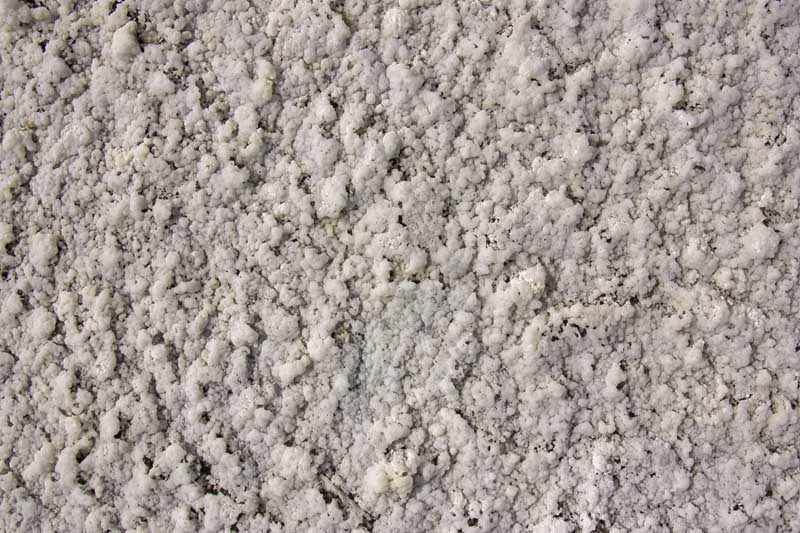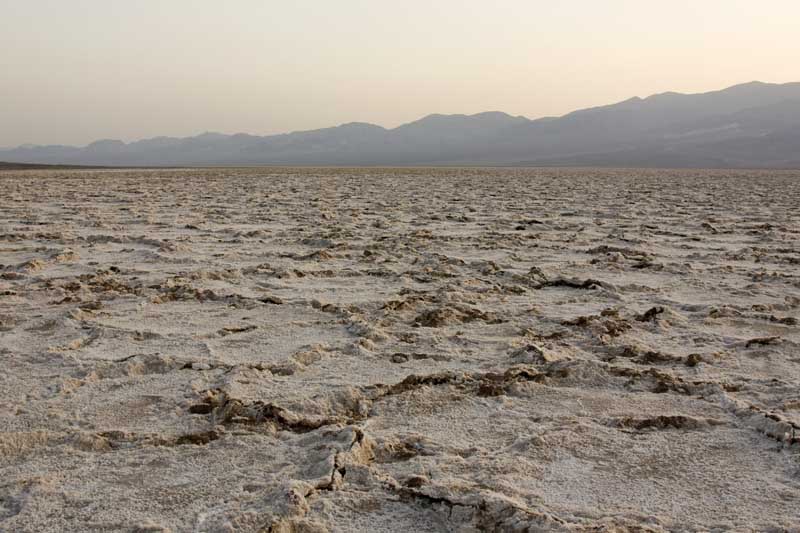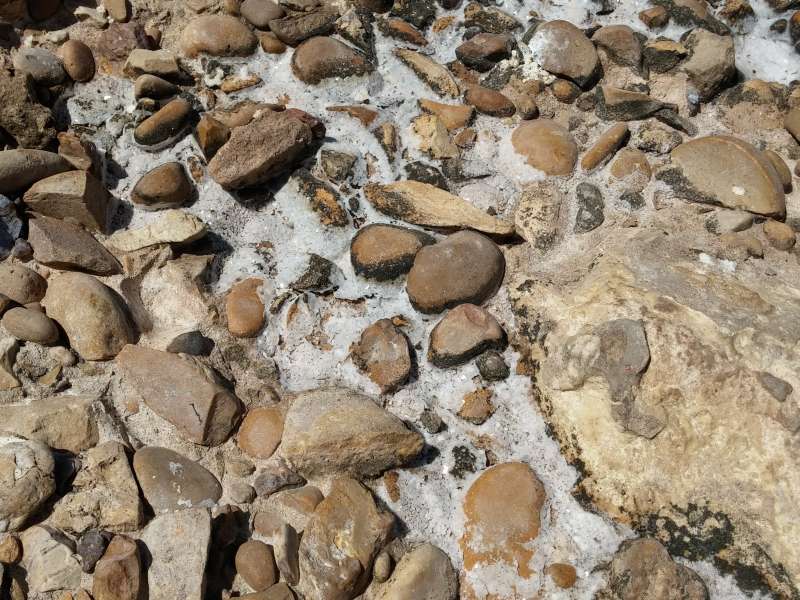Halite is a mineral commonly known as table salt, rock salt or simply salt. Halite is composed of sodium and chlorine in equal proportions (NaCl). Rock salt and halite are not exactly synonymous terms. Halite is a mineral, rock salt is a type of rock that is predominantly composed of halite. Halite is an evaporite mineral. These are water-soluble minerals that crystallize out of concentrated aqueous solutions.

Halite with other salts on the shore of Mono Lake in California. Width of view approximately 50 cm.

Badwater Basin in Death Valley is the lowest point in North America. The floor of the basin is covered with halite.
Crystals of halite are cubic but that does not mean that they are cubes in shape. Their cleavage is cubic because of internal crystal structure, the angles between cleavage planes are 90 degrees but the crystals may be elongated. It simply depends on external forces that shattered the crystals into many rectangular blocks. Take a look at the first picture below which shows halite crystals with various shapes.
http://picasaweb.google.com/107509377372007544953/Rocks#5798776677524013842
Halite crystals demonstrating perfect cubic cleavage.
http://picasaweb.google.com/107509377372007544953/Rocks#5848243670328049762
Crystal of halite. Pure halite is colorless and translucent. Width of the sample is 5 cm.

Halite crystals covering a quay on the Atlantic coast in Morocco. These salt crystals formed when seawater evaporated.
Pure halite is a transparent mineral. Halite is pretty soft (2.5 on Mohs scale) and gets easily scratched. So in reality the crystals are mostly not perfectly transparent. Impurities give various shades of color to halite. Especially rock salt often has light orange, yellow, gray, or brown color. Blue and violet colors are caused by lattice imperfections. Such defects may result from exposure to radioactivity.
Halite is very easily soluble in water as we all know because this mineral has a salty taste. It would have no taste at all, if it were not soluble. The taste of halite is one of the basic tastes that out tongues easily detect. For some reason people love this taste. Most of us tend to consume much more salt than really needed (hundreds of times more than needed is not unusual because processed food is full of salt). One of the reasons we love salt may be the fact that it is not only salty, but salt also helps to enhance the flavor of food which is an important component of taste.
Crystals of halite are very brittle. You can easily make many small rectangular halite crystals from one big crystal. All it takes is just a light hammer blow. I have written an article which attempts to explain why halite and other ionic compounds are so brittle: What makes minerals brittle.
Solution of halite in water is essential for humans and other animals. Our nerves can not function without salt. Our cells would quickly swell because of osmosis and death would be inevitable without salt. That doesn’t mean that we should drink saltwater. Normal freshwater is adequate because it does contain salt from weathered rocks. Water flowing in rivers carries it to oceans which become more salty as time goes by because water escapes oceans by evaporation but salt does not. That does not mean that there is no mechanism to remove salt from oceans. Salt forms in shallow lagoons in hot areas but water has to have a really high concentration of salt for that.
Salt is an important industrial raw material. Halite is of course used in food but this is not the most important use nowadays. Salt is used as a principal source of chemical element chlorine. Chlorine gas and hydrochloric acid are the major products for which halite is a raw material. Halite is used in agriculture (fertilizer, weed killer, cattle feed stocks). Halite is extensively used as a road deicer in certain regions.
Salt should be really inexpensive and widely available if it is used to keep roads ice free. Indeed, this is the case. Many raw materials like metal ores and crude oil are non-renewable resources which no doubt become more and more expensive in the future but this is not the case with salt. We have more than enough of it for any need that may arise in the future. It is pretty safe to say that we will never run out of salt.
However, in the past, things were different. Salt used to be very expensive commodity and certain cities in southern Europe (especially Venice) became rich because of salt trade. Even the word “salary” (salario in the Italian, salarium in the Latin) comes from sal (salt). Venice (and even Roman Empire well before that) used to make lots of money by selling salt before people learned that you can get salt by simply evaporating sea water in ponds.
Nowadays salt is either mined, collected from evaporation ponds or pumped out from salt deposits. In order to do that, water is pumped into a salt deposit through a drill hole. This water dissolves the salt to form a brine which is pumped out. The brine is either used directly by an industrial plant or pumped to an evaporation pond.
http://picasaweb.google.com/107509377372007544953/Rocks#5798776692398641602
Evaporation pond in Israel. White material in the background is salt.
http://picasaweb.google.com/107509377372007544953/Rocks#5798776696077098210
The Dead Sea is a salt lake between Israel and Jordan. Its surface is more than 420 meters below sea level. You can not go lower than that on land but new record is set every year because the water level of the Dead Sea is constantly falling. The Dead Sea is hypersaline — every liter of water contains over 330 grams of salt, mostly dissolved halite. This is almost ten times more than in sea water. That increases the density of water (1.24 g/cm3) and makes drowning pretty much impossible. It is me on the picture above floating effortlessly in the water. Swimming in the Dead Sea is an interesting experience. I am used to cool lakes in northern Europe where swimming is really refreshing experience. The water in the Dead Sea was hot (although certainly cooler than the air temperature which was about 45 °C that day) and had a funny soapy feel. If I were living next to Dead Sea, I would not go swimming there regularly. It simply does not make any sense. It gives no relief from hot weather and when you have even a tiny skin scratch somewhere it surely does hurt while trying to swim there. The bottom of the Dead Sea near the shore is not covered with normal sand. It is salt. This is weird place indeed.
http://picasaweb.google.com/107509377372007544953/Rocks#5798776706728102082
The Dead Sea is shrinking because people consume the water of the River Jordan that should feed the lake. This is sad but so far no solution to the problem has been found. Former bottom of the Dead Sea is on the picture above. Now it is just a barren land covered with salt and mud. However, the Dead Sea, unlike the Aral Sea, is likely not destined to disappear entirely. At least not in the near future because the lake occupies a tectonic depression, the Jordan Rift Valley, which is basically an extension of the Red Sea. Because of that, the Dead Sea is deep (377 meters) and will make tourists (over one million every year) happy for many years to come.
http://picasaweb.google.com/107509377372007544953/Tenerife#5821093330984695138
Salt pans on La Palma, Canary Islands. Water in salt pans is often colored because of various extremophile microorganisms. Alga Dunaliella salina is one of the most common of them. Shrimps that also tolerate high salinity feed on it. Birds, for example flamingos, look for shrimps as a food source but not only food. Their beautiful pink wing coloration is a result of pigments (carotenoids) produced by these microorganisms that live in saline water.
http://picasaweb.google.com/107509377372007544953/Tenerife#5821093331599709378
Salt extracted from seawater on La Palma.
Very informative, thank you very much!
Thanks! 🙂